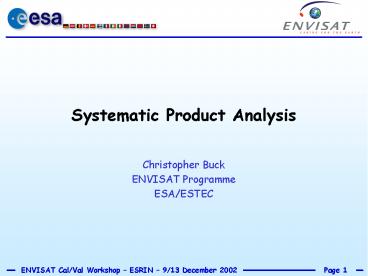Systematic Product Analysis PowerPoint PPT Presentation
Title: Systematic Product Analysis
1
Systematic Product Analysis
- Christopher Buck
- ENVISAT Programme
- ESA/ESTEC
2
Purpose
- ASAR generates typically 100 products per day
- Each contains vital information on the health of
the instrument, level settings, processing
problems etc - Systematic product analysis is required to
monitor the instrument and product status,
providing inputs to the instrument and processor
operation and flagging any problems in a timely
fashion
3
Product Types Ingested for Analysis
- Module Stepping Mode ASA_MS__0
- Image Mode Medium Resolution ASA_IMM_1
- Wave Spectra ASA_WVS_1
- Wave Image ASA_WVI_1
- Global Monitoring ASA_GM1_1
- Alternating Polarization Medium Resolution
ASA_APM_1
4
Module Stepping Mode Analysis
- Source packet chirps read in
- Compressed with ideal chirp
- Gain and phase of each module determined
- Transmit and Receive
- Horizontal and Vertical Polarization
- Time stamped
- Entered into Database
5
Module Stepping Mode Database
A1-E4
H or V
1-16
ASA_MS__0.N1
6
Module Stepping Mode Analysis
- Provides
- Instant health check of all modules tx/rx, H/V,
Gain/Phase - History of tx/rx, Gain/Phase for each module and
each polarization - Phase and amplitude errors as input into antenna
pattern analysis
7
Module Stepping Mode Health Check
lt 1 LSB error gt 1 LSB error gt 2 LSB error gt 3 LSB
error
8
Pattern and Gain Calibration
Antenna Gain Test Results
Transponder
Beam Antenna Gain
External Characterisation
Embedded Row Test Results
Internal Calibration
Beam Coefficients
Module Stepping
Antenna B/F Near-field data
Beam Radiation Pattern
Rain Forest
Doppler Spectrum
Antenna B/F Test Results
9
Module Stepping Mode History
- Long-term comparison against pre-launch reference
data set shows trends in module behaviour
10
Antenna Stability - Tx
? 0.25dB
11
Antenna Stability - Rx
? 0.4dB
12
Internal Calibration
- ASAR is equipped with
- an automatic temperature
- compensation scheme to
- compensate for phase/gain
- drifts at T/R module level
- Direct monitoring of any
- residual gain drifts for
- later correction
- Continuous measurements
- even during data acquisition
T/R Module (1 of 32x10)
Radiating Row
Signal BFN
Tx Main
Rx Main
- Use of special calibration signals (cal pulses)
and additional hardware (cal network)
13
Image Product Analysis
- Product header parameters systematically
extracted from ASAR products and entered into
database for subsequent analysis - Parameters extracted are
- Internal calibration pulses (P1, P1a, P2 and P3)
for each of the 32 rows - Product quality parameters (3dB IRF width,
sidelobe level, ISLR, peak location, chirp power
and scaling factor) - Doppler
14
Image Product Database
?
?
32
15
Interface
- Implemented in IDL
- Backed by MySQL Database
dummy
dummy
dummy
dummy
16
Product Analysis
- Confirmation of correct functioning of internal
calibration - Generation of INS files with computed default
calibration pulse values - Provides overview of main quality parameters
- Confirmation of correct pointing and correct
Doppler estimation
17
Calibration Pulse Analysis - Wave
18
Calibration Pulse Analysis Wave P2
Spurious results, if ignored, can lead to
problems in processed imagery
19
Calibration Pulses - APM
20
Doppler Analysis
- In white, 27000 Doppler estimates from Wave Mode
Data - In red, the predicted Doppler calculated from
orbit parameters
21
Doppler Estimation
22
Doppler Bias
Subtracting the predicted Doppler from that
estimated from the image data shows a bias of
54Hz
23
Doppler Analysis Effect of Relief
Doppler prediction based on WGS84 hence high
altitude of Greenland results in an offset
24
Internal Calibration
Wide Swath, SS5, HH
25
Calibration Pulse Phase Unwrapping
- PF-ASAR currently has a problem when unwrapping
the phase of the calibration pulse - This introduces noise in the elevation gain
factor calculation - In-house code unwraps correctly and will soon be
implemented in PF-ASAR
White PF-ASAR Red In-house code
26
Corrupted Wave Pulses
- Normal wave pulses have blocks of 108 samples of
constant amplitude - Occasional corrupted wave pulses display
irregular amplitude
1st ten source packets plotted
27
Corrupted Wave Pulses 2
- Corrupted pulses change the elevation gain
- Problem is not restricted to the northern
hemisphere - Not deterministic meaning that if it were
dependent on the timing then it would always
appear in the same SWST segment
28
Corrupted Cal Pulses in Wide Swath
- P2 calibration pulse in wide swath mode is
corrupted for sub-swaths 4 and 5
SS1
SS2
SS3
SS4
SS5
29
Gain Droop Compensation
- P2 gain droop compensation is incorrect when the
calibration sequence changes (cal order 0 or 1)
in Wide Swath mode
- Lower curve is from PF-ASAR with droop
compensation using pre-launch characterization
data - Upper curve is in-house code and no compensation
30
Conclusions
- Systematic product analysis proving to be
extremely useful for - Troubleshooting
- Health checking
- Consistency checking
- Updating processor parameters
- So far over 2500 products ingested
- 949 IMM
- 1346 WVS
- 213 WSM
- 57 APM
31
Conclusions 2
- Antenna in great shape, very good stability
- 0.25dB tx, 0.4dB rx
- Doppler tracking error 50Hz consistent with
10-15 mdegrees of mispointing - Problem with noisy calibration pulse gains
identified due to phase unwrapping - solution
ready - Problem with P2 gain droop compensation
identified solution at hand
32
Conclusions 3
- Ongoing problems requiring further analysis
- Occasional corrupted Wave pulses
- Corrupted cal pulses in Wide Swath Mode
- Further problems with the internal calibration
are just starting to be addressed in AP and GM
modes

